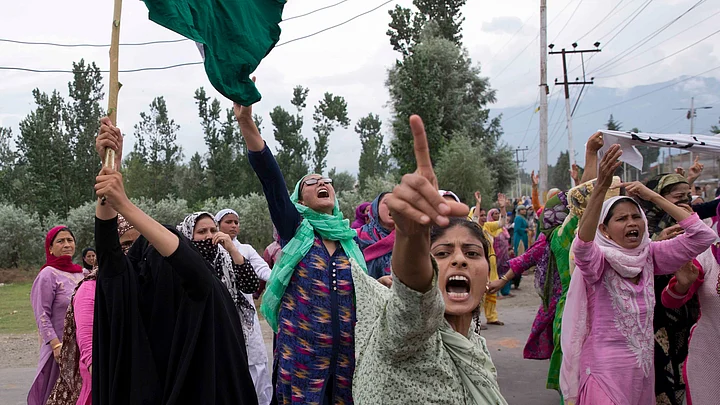With means of communication such as mobile connectivity, internet and telephone lines still cut in Jammu and Kashmir, there is very little information on the situation in the erstwhile state. Most journalists based in the Valley are finding it nearly impossible to file stories.
Some even had to go to the extent of sending stories on a pen drive through people travelling from Srinagar to Delhi. The journalists reporting from the Valley are also said to be facing many restrictions in their movement.
However, stories are coming out of the Valley and there is a sharp contrast in the kind of reportage one is seeing from Indian and foreign media.
Did Indian Media Blackout A Protest?
A report by Reuters on Friday, 9 August, claimed that a massive protest took place in Soura in the northern part of Srinagar’s downtown area, in which 10,000 people took part.
The Union Ministry of Home Affairs called the report fabricated and claimed that no protest had more than 20 people.
However, BBC released a video which clearly showed a large number of protestors waving flags and chanting slogans. One part of the video also showed the protestors being fired upon by the security forces.
Several people on social media questioned the veracity of the report by claiming either that the video was an old one or that it was from Pakistan Occupied Kashmir. However, the video clearly shows a place called Ramzan Memorial, which is located in Srinagar’s Soura area. Also, people can be seen carrying banners saying ‘Abrogation of Article 370 Not Acceptable for Us’, which indicates that the protests took place after the government’s decision to scrap Jammu and Kashmir’s special status.
Al Jazeera also reported on this protest and claimed that thousands of people had hit the streets.
The exact number of people who took part in the protest, is not clear. The local administration denied the presence of over 10,000 protestors and claimed that not more than 300 people were present.
However, most Indian news channels appear to have blacked out the protest. In sharp contrast to this story are videos posted by Asian News International which shows people in Srinagar walking on the streets and queuing up outside ATMs.
Most of ANI’s videos from the Valley have been of people walking on the streets, which is being cited as a proof of “normalcy” in the Valley.
ANI posted a video of vehicular from the Dalgate area of Srinagar, which was also cited as a sign of normalcy by a few people on social media.
On Saturday, ANI also posted a video of National Security Adviser Ajit Doval “interacting with locals” in Anantnag, which the agency described as a “hotbed of terrorist activities”.
Pictures Tell 3 Different Stories
Like ANI’s videos, the pictures released by the agency also try to give an impression of normalcy in the Valley.
But even these pictures of ‘normalcy’ show that shops remain shut.
Most of the pictures released by Press Trust of India mostly focussed on the shutdown in Kashmir, and not on the signs of so-called ‘normalcy’. This picture for instance, showed how Lal Chowk, which many call the heart of Srinagar, was complete deserted. By shooting through the barbed wire, the picture also seems to convey a sense of siege in the Valley.
Another PTI picture showed a desolate marketplace in Srinagar with only one Kashmiri civilian and two security personnel in the frame.
Here again, it is the foreign media which managed to capture glimpses of angry Kashmiris protesting in the Valley. For instance, Associated Press released pictures of protests that took place in downtown Srinagar on Friday.
Like the BBC video, the posters in the picture show banners saying ‘Abrogation of Article 370 Not Acceptable to Us’. The picture appears to be from the same protest, which took place in Soura.
The next picture is particularly important as it shows Kashmiri women protesting against the Union government’s decision.
This is in contrast to the the claims made by the BJP and a few Indian news channels that Kashmiri women are in favour of the abrogation of Article 370 and Article 35a.
The administration has downplayed the protests and the extent of the shutdown. They say that the protests have been sporadic and the turnout low by Kashmir standards. The local administration also claims that shops in many parts of Srinagar are open and people are shopping for Eid.
Partly, the different stories being told through these pictures and videos stem from Srinagar’s complex political geography. In the past, it was quite common to see a complete shutdown in the JKLF stronghold Maisuma but a short walk from there would lead one to Polo View and Lal Chowk, which would be bustling with tourists and customers. Similarly, one would see tourists in Dalgate but there would be protests a little to the North in Srinagar’s Downtown area.
It is crucial which area a media organisation chooses to report from. Those who seek to show normalcy, are most likely to be found clicking pictures and shooting videos in Dalgate, Boulevard Road and the area near the Srinagar Airport and least likely to venture into Downtown, unless it is under the protection of security forces.
(At The Quint, we question everything. Play an active role in shaping our journalism by becoming a member today.)
